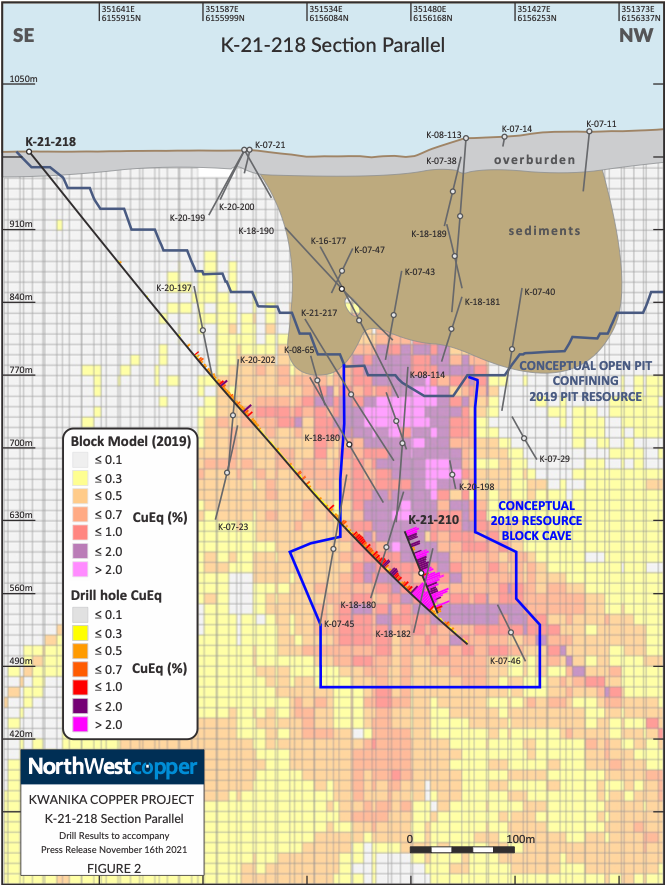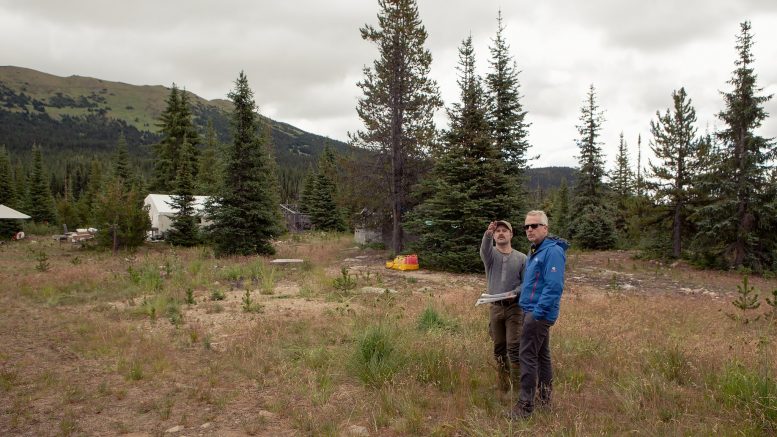NorthWest Copper (TSXV: NWST; US-OTC: NWCCF) has released the latest results from five drill holes into the high-grade copper-gold porphyry deposit of the Kwanika project, further extending the high-grade core.
The news sent the British Columbia-focused explorer’s Toronto-quoted equity soaring more than 13% at market open on Tuesday, given that the results demonstrate the wide distribution of high grades throughout the deposit.
All five holes have intercepts of greater than 1% copper-equivalent and contain meaningful gold grades. According to the company, these results reinforce the high-grade nature and continuity of the deposit.
Highlight results include hole K-21-210 which returned 416.5 metres of 0.87% copper equivalent, including 100.50 metres of 1.91% copper-equivalent. Hole K-21-216 returned 250.6 metres of 1.36% copper-equivalent, including 71.9 metres of 2.64%, while hole K-21-218 returned 366 metres grading 0.61% copper-equivalent, including 106.1 metres of 1.27% copper-equivalent.
The drill results represent the continuation of the angled-hole program designed to expand and improve the high-grade part of the Kwanika resource. The holes are in the ‘Boot’ target area, which forms the conceptual block cave portion of the resource defined by the 2019 resource shape.
The holes are below and down-plunge from the previously released 2021 near-surface drilling, which targeted the conceptual open pit defined in the 2019 study.
CEO Peter Bell said in a media release the latest results were a reminder that very high grades characterize the porphyry mineralization.
“Every hole in this release has material thicknesses of greater than 1% copper-equivalent, demonstrating the wide distribution of high grades throughout the deposit. In addition, hole K-21-216 includes a significant thickness of material above 2.5% copper-equivalent, including a significant gold contribution,” said Bell.

General location map of NorthWest Copper’s Kwanika copper-gold property in B.C. Credit: NorthWest Copper.
In a recent interview with MINING.COM, Bell outlined NorthWest’s goals at Kwanika in 2021 included expanding the high-grade zone and improving the grade within it by drilling angled holes across mineralized structural zones with closer-spaced drilling.
“All our results to date have provided results exceeding these goals,” he said.
NorthWest has focussed on the high-grade portion of Kwanika and adjacent high-grade Stardust deposit since the company was created in March via the acquisition by Sun Metals of Serengeti Resources. The deal synergistically married Sun Metals’ Stardust asset with Kwanika to extract greater operating efficiencies at a reduced cost.
Several high-grade Kwanika assay results followed releases of favourable Stardust metallurgy in April and an expanded high-grade Stardust resource in May.
These high-grade results, the previously released near-surface results, and drill hole K-21-217 will support an updated Kwanika resource planned for release before year-end. “We still have additional results to be received and released, including additional holes from Kwanika, Stardust and East Niv,” said Bell.
Drillhole K-21-217, reported in early October, returned the highest-grade copper-gold interval ever intersected at the deposit, returning 235.45 meters of 2.92% copper equivalent, including 153.25 meters of 4.13% and 9.40 meters of 33.6% copper equivalent.

According to NorthWest, the copper-gold porphyry-style mineralization is hosted by diorite and monzonite intrusions. The highest-grade intervals correlate with an abundance of well-mineralized quartz-sulphide veins containing chalcopyrite variably accompanied by bornite. Additional disseminated mineralization occurs in intense potassic alteration between and related to the veins.
Mineralization is primarily hypogene sulphide, but a zone of paleo-supergene mineralization is typically present at the top of the mineralized interval. Late to post-mineral dykes locally cut the copper-gold mineralization.
The Stardust project hosts a compliant resource of 1.96 million tonnes indicated grading 2.59% copper equivalent, for 112.1 million pounds of metal, and another 5.84 million tonnes inferred at 1.88% for 242.2 million pounds copper equivalent.
Kwanika hosts a combined open-pit and underground measured and indicated resource estimate of 223.6 million tonnes grading 0.41% copper equivalent for 1.32 million pounds of metals.
“We’re focused on the grade rather than the size here, and our drill program is really around trying to enhance the high-grade part,” Bell told MINING.COM.
“Kwanika has been around since 2006. It’s a known entity in its previous state, which entails an extensive, medium-grade British Columbia porphyry. But that’s not what we’re focused on.
“What we’re focused on is taking the best part of it and putting that into our plant. So, its size, to some degree, depends on what cut-off grade we choose, in terms of what portion of it goes into our plan. And that really is something that’s going to be determined by the pre-feasibility study.
“All I can say is that we believe we’ll be enhancing the grade and enhancing the size of the high-grade portion of the deposit versus what’s been put out in the resource previously. So, we’re really pumped about this drilling because we think it has really in a lot of ways exceeded our expectations in terms of the result on the grade side,” said Bell.
NorthWest’s shares traded at 90c apiece in Toronto at press time, capitalizing it at $110.42 million (US$87.83 million).


Be the first to comment on "NorthWest Copper extends Kwanika high-grade zone"